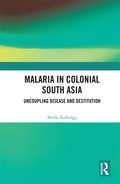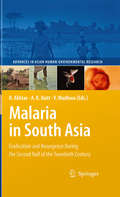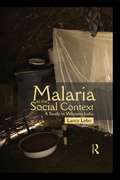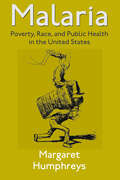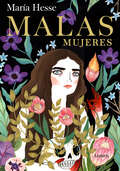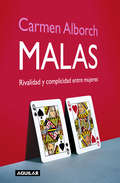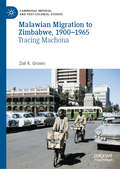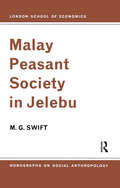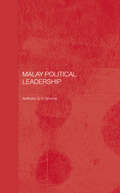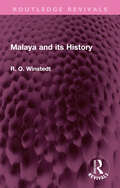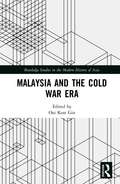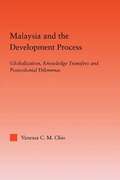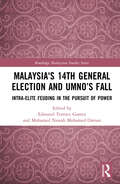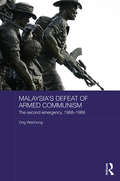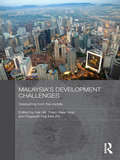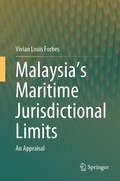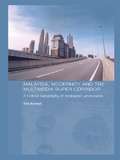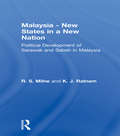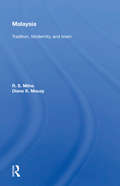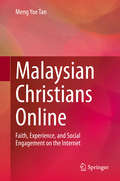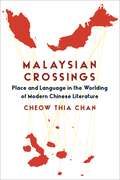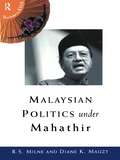- Table View
- List View
Malaria in Colonial South Asia: Uncoupling Disease and Destitution
by Sheila ZurbriggThis book highlights the role of acute hunger in malaria lethality in colonial South Asia and investigates how this understanding came to be lost in modern medical, epidemic, and historiographic thought. Using the case studies of colonial Punjab, Sri Lanka, and Bengal, it traces the loss of fundamental concepts and language of hunger in the inter-war period with the reductive application of the new specialisms of nutritional science and immunology, and a parallel loss of the distinction between infection (transmission) and morbid disease. The study locates the final demise of the ‘Human Factor’ (hunger) in malaria history within pre- and early post-WW2 international health institutions – the International Health Division of the Rockefeller Foundation and the nascent WHO’s Expert Committee on Malaria. It examines the implications of this epistemic shift for interpreting South Asian health history, and reclaims a broader understanding of common endemic infection (endemiology) as a prime driver, in the context of subsistence precarity, of epidemic mortality history and demographic change. This book will be useful to scholars and researchers of public health, social medicine and social epidemiology, imperial history, epidemic and demographic history, history of medicine, medical sociology, and sociology.
Malaria in South Asia
by Rais Akhtar Ashok K. Dutt Vandana WadhwaThis highly topical book provides an in-depth account of the South Asian experience with the deadly disease that has held this region hostage for millennia. The book touches specifically on the resurgence of malaria experienced in the second half of the twentieth century, which occurred just a few years after malaria was thought to have been virtually eradicated from the region. The progress of this reappearance across space and time, as well as its causes and consequences, are discussed. The book also covers past, present and future ways to curb, control and ultimately, conquer malaria. As malaria continues to ravage the developing world, even in today's 'age of science', this is a particularly relevant book, especially as most studies analyze the problem in Africa, the continent that bears the brunt of this disease. Here, the authors call attention to challenges in South Asia, home to an immense at-risk population. The chapters in this book use a range of conceptual frameworks, quantitative analyses and descriptive aapproaches, finding that malaria is not just a complex disease driven by highly adaptive agents and vectors thriving in particular ecologies, but also a social concern deeply related to the region's cultural traditions, financial and developmental shortfalls, and inexorably related to political will. The book comprehensively deals with all aspects of the malaria situation in South Asia, and is invaluable to upper level students as well as emerging and established scholars in the fields of medical geography and epidemiology, Asian studies and development studies.
Malaria in the Social Context: A Study in Western India
by Lancy LoboThis book underscores how, apart from bacteriological factors, human behavioural characteristics as well as the socio-cultural factors that affect people’s lives contribute to the risk for and prevention of infection, with particular focus on malaria. It argues that the implementation of malaria-control measures can be successful only if it considers the human response to malaria and control measures. Any new tool which is introduced in a particular area — be it a new vaccine, a new drug combination, the promotion of impregnated bed nets, spraying of insecticides, or improved home management — will be effective and sustainable only if it is adapted to needs of the local population, i.e., if it makes sense to them. This volume also studies traditional knowledge systems with respect to health and malaria, arguing that local knowledge about infection is the result of an amalgamation of the biomedical and the traditional. By attempting to identify how traditional and biomedical elements interrelate in local illness concepts, it hopes to assist health interventionists in providing efficacious health education and awareness among people.
Malaria: Poverty, Race, and Public Health in the United States
by Margaret HumphreysFrom a prominent medical historian, “a fascinating story of the spread of malaria through the USA following its introduction in the seventeenth century” (Nature Medicine).Margaret Humphreys presents the first book-length account of the parasitic, insect-borne disease that has infected millions and influenced settlement patterns, economic development, and the quality of life at every level of American society, especially in the south and during its peak in the nineteenth century.Humphreys approaches malaria from three perspectives: the parasite’s biological history, the medical response to it, and the patient’s experience of the disease. It addresses numerous questions including how the parasite thrives and eventually becomes vulnerable, how professionals came to know about the parasite and learned how to fight it, and how people view the disease and came to the point where they could understand and support the struggle against it.In addition Malaria: Poverty, Race, and Public Health in the United States argues that malaria control was central to the evolution of local and federal intervention in public health, and demonstrates the complex interaction between poverty, race, and geography in determining the fate of malaria.“A masterpiece . . . recommended reading for anyone involved in or interested in health care.”?Southern Medical Journal“The lack of jargon makes the book accessible to a wide audience.”?Journal of the History of Medicine
Malas mujeres
by María HesseUna historia de las mujeres que han encarnado el mal, llena de humor e inteligencia, por la autora de Frida Kahlo y El placer, con más de 200.000 lectores. TODAS #MALASMUJERES UNO DE LOS DIEZ LIBROS MÁS ESPERADOS DE 2022 SEGÚN ESQUIRE NI LOCAS, NI TONTAS, NI PROVOCADORAS, NI FATALES: ¡MUJERES, BIENVENIDAS AL AQUELARRE! Desde la aparición de los primeros mitos, lo universal ha sido la narración de los hombres, esa visión masculina que dibujó a unos y a otras, nos dijo cómo debíamos ser -puras, dóciles, amorosas- y previno al mundo de las malas mujeres, ya fueran vengativas gorgonas, crueles madrastras, problemáticas Pandoras o Evas incautas que cargaron con la culpa de nuestro destino. En su personalísima versión, María Hesse da una vuelta de tuerca a esas princesas pasivas, brujas perversas, malas madres, femmes fatales, locas pasionales y secundarias perfectas, y, de Madame Bovary a Sarah Connor, de Juana «la Loca» a Yoko Ono, de Helena de Troya a Monica Lewinsky, de Medusa a Zahara o a Nevenka, reivindica la necesidad de encontrar otros referentes, nuevas lecturas de la Historia e inspiración para ser simplemente mujeres en el mundo en que vivimos. «Ahora sabemos que no hay que tener miedo a salirse de esas líneas caprichosas que otros marcaron, y que las que abrieron esas grietas buscando otros horizontes no estaban locas, ni eran perversas ni malos ejemplos para otras. Si acaso fueron mujeres valientes, fuertes, atrevidas, decididas. Rompedoras. Y si las llaman malas mujeres que se lo llamen; las paredes han caído y nosotras ya no estaremos ahí para oírlo».María Hesse La crítica ha dicho:«Con unas ilustraciones bellísimas y repletas de personalidad, su nuevo libro recupera la vida de las "malas mujeres" en una burla irónica e inteligente [...] porque igual no fueron malas mujeres, sino mujeres valientes, fuertes y rompedoras que merecen que Maria Hesse cuente (y dibuje) su historia.»Alberto Hernando, Esquire «María Hesse es uno de esos nuevos diamantes en bruto de la ilustración.»Harper's Bazaar «El dibujo no como horizonte escapista y mero entretenimiento, sino como reflejo de realidades y fuente de revelaciones.»Javier Ors, El Confidencial «Un estilo inconfundible que busca fusionar lo sintético con lo orgánico.»Javier Rubio Nomblot, ABC Cultural «[El trazo de Hesse]: personal, bello y delicado, es inconfundible.»Isabel Loscertales, Woman «Una obra vanguardista, íntima y conmovedora.»Lidia González, Traveler «Hesse tiene la enorme virtud de hacer que ídolos inalcanzables nos puedan parecer tremendamente cercanos.»Juan Rodríguez Millán, Cómic para todos «A través de su trazo suave y visceral habla de las luces y sombras de muchos referentes, de libertad, de amor, de amigas, de fuegos, de poesía, de imposiciones canónicas de belleza y de coños.»Marina López, Soria Noticias «La obra de María Hesse ha sido expuesta en diversas exposiciones y cuenta con un trabajo personal donde la sensibilidad y la mujer son las grandes protagonistas.»Seviocio
Malas: Rivalidad y complicidad entre mujeres
by Alborch, CarmenDe nuevo, como en su libro anterior, Carmen Alborch acierta al plantear, desde la franqueza intelectual, cuestiones que de verdad interesan a las mujeres. «Nos queremos, nos envidiamos, nos compadecemos, nos enfadamos, nos prestamos a la confidencia, nos apoyamos, competimos, nos divertimos y aprendemos juntas», escribe Carmen Alborch en la introducción a esta obra. La autora de Solas nos habla en las páginas de este libro de algunas cuestiones clave en las relaciones entre mujeres en el comienzo del siglo XXI: De la rivalidad que las ha enfrentado históricamente y aún las enfrenta por los mismos o nuevos motivos; de la presunción de #maldad# extendida a casi todas ellas por las tradiciones culturales hegemónicas en cada época histórica, de mujeres relevantes en numerosos y diferentes campos de la actividad humana, célebres o anónimas. Y también se refiere a la complicidad entre mujeres, esa hermosa connivencia tejida en mil alianzas y relaciones de muy variada naturaleza #algunas seculares, milenarias incluso-, otras más actuales con clara dimensión política, donde las mujeres se encuentran para que sus voces sean oídas y respetadas.
Malawian Migration to Zimbabwe, 1900–1965: Tracing Machona (Cambridge Imperial and Post-Colonial Studies)
by Zoë R. GrovesThis book explores the culture of migration that emerged in Malawi in the early twentieth century as the British colony became central to labour migration in southern Africa. Migrants who travelled to Zimbabwe stayed for years or decades, and those who never returned became known as machona – ‘the lost ones’. Through an analysis of colonial archives and oral histories, this book captures a range of migrant experiences during a period of enormous political change, including the rise of nationalist politics, and the creation and demise of the Central African Federation. Following migrants from origin to destination, and in some cases back again, this book explores gender, generation, ethnicity and class, and highlights life beyond the workplace in a racially segregated city. Malawian men and women shaped the culture and politics of urban Zimbabwe in ways that remain visible today. Ultimately, the voluntary movement of Africans within the African continent raises important questions about the history of diaspora communities and the politics of belonging in post-colonial Africa.
Malay Kinship and Marriage in Singapore (LSE Monographs on Social Anthropology #Vol. 21)
by Judith DjamourDr Djamour spent two years in Singapore, both in the city and in a Malay fishing village, and her first-hand account draws a lively and sympathetic picture of behaviour within the family and between kinsmen. It is nonetheless an important contribution to social anthropology and discusses, as its central topic, the instability of Malay marriage. The causes and consequences of this phenomenon, which involve social, economic, and psychological considerations, are analysed in some detail. The social picture which emerges has wide validity throughout the country and should prove of value to all who seek a fuller knowledge of Malay society.
Malay Peasant Society in Jelebu (LSE Monographs on Social Anthropology #Vol. 29)
by M. G. SwiftFirst published in 1939 and long out of print, this book remains unique as the only full and detailed account by a social anthropologist of a complete pagan Polynesian ritual cycle. This new single-volume edition omits some of the Tikopia vernacular texts, but includes a new theoretical introduction; postscripts have also been supplied to some of the chapters comparing the performances of 1928-9 with those witnessed by Professor Firth on his second visit to Tikopia in 1952. There is a specially written Epilogue on the final eclipse of the traditional ritual, based on a third visit by the author during the summer of 1966.
Malay Political Leadership
by Tony ShomeThis book demonstrates how particular values and 'notions of leadership', which underpinned traditional Malay leadership, have played a crucial role in the political evolution of the modern Malaysian nation. The author discusses the nature of Malay 'notions of leadership', and considers this throughout the Malay world at the local as well as at the national level, and goes on to describe and analyse leadership from pre-independence leadership in the colonial period through the rule of Malaysia's four prime ministers. He draws on anthropology, psychology, and political and economic history to show how Malay leaders have kept within the established track of the Malay value system, responding in particular to the expectation of their people to provide a sense of national identity and unity against the complex background of the Malaysian 'mosaic', while addressing the needs of the wider multi-ethnic community. Throughout the evolutionary development of Malay leadership, symbolisms for the perpetuation of leadership veneration persisted in its institutions and in the sublime power of the sultans. The Malay case offers one of the most remarkable studies of leadership, in its attempt to maintain indigenous primacy in a large multi-racial environment, subscribing to western democracy for its governance while retaining conservative Islamic values. This book is a significant contribution to the understanding of the evolution of leadership. It begins with an explanation of the early Malay World belief system and progresses to the period of colonization and nationalism. It then follows through the dynamics of modern politics encapsulating the biographical profiles of all Malaysia's Prime Ministers - Tunku, Razak, Hussein, and Mahathir - in three aspects: national unity, the economy and foreign affairs. The analysis of Mahathir's leadership extends into the new millennium. This is the only book with biographical profiles of all of Malaysia's Prime Ministers. This book will be of interest to students, academics, politicians, foreign affairs specialists and any reader interested in leadership studies and about Malaysia's political and economic history.
Malaya and its History (Routledge Revivals)
by R. O. WinstedtFirst published in 1948, Malaya and its History is a history of Malaya ranging from the thousand years of Hindu influence to the eras of Portuguese and Dutch rule, and from the establishment of the British protectorate to Malayan independence in 1957. There are chapters on law, trade, industry and the social services. This book will be of interest to students of history, southeast Asian studies, and cultural studies.
Malayasia's Parliamentary System: Representative Politics And Policymaking In A Divided Society
by Lloyd D MusolfMalaysia, a new nation whose very existence depends on holding disparate ethnic groups in balance, is an example of a developing nation whose legislature does influence policy. This pioneering survey and analysis of the Malaysian parliament carefully documents and interprets the interaction of legislator, party, and voter in Malaysia. The study ind
Malaysia and the Cold War Era (Routledge Studies in the Modern History of Asia)
by Ooi Keat GinFrom the end of the Second World War in 1945 to the collapse of the Soviet Union in 1991, there was a great deal of turmoil, tension and violence in what became Malaysia as a result of the 1963 Federation; upheavals included the Malayan Emergency of 1948・1960, the independence of Malaya in 1957, Konfrontasi with Indonesia of 1963・1966, the Philippines’ claim to Sabah, the Sarawak Communist Insurgency (1962・1990) and the Second Malayan Emergency of 1968・1989. This book breaks new ground in arguing for a longer trajectory of the Cold War, tracing this phenomenon back to 1920s’ colonial Malaya and Sarawak. Many new research findings showing how Malaysia coped with and overcame the many trials, challenges and difficulties are presented here, further enriching the historiography.
Malaysia and the Developing World: The Asian Tiger on the Cinnamon Road (Routledge Malaysian Studies Series)
by Jan StarkAs Malaysia’s economy grows and flourishes, strong new links are being forged with other developing countries in the region and beyond. This book traces the ways in which age-old organizational, political, religious and trade networks between Nusantara, the Malay World, and Central Asia, East Africa and the Middle East have changed in recent years. The book argues that these old links are being revived by new forms of globalization, modernization and knowledge transfer that are developing and implementing non-western models of governance, often in direct reference to Islam. The book goes on to explain how, as Malaysia develops new links with Indian Ocean countries, many of them Muslim countries, a new style trading network is being formed, a network with Islamic characteristics, which echoes Indian Ocean Islamic trading networks of earlier times. Interspersed with interesting methodological insights into the latest network, transnational and spatial theories, the book provides detailed case studies of Malaysia’s and Southeast Asia’s trade and numerous other links with Indonesia, Egypt, Zanzibar, Comoros and Central Asia, and concludes by assessing how Malaysia’s and ASEAN’s new style network is likely to develop and influence wider global networks. Written with a depth of knowledge reflective of the author’s many years of research throughout Asia, this book gives a real insight into how Malaysia’s mentalities, traditions and ways of thinking are being applied to its interactions with its immediate neighbours and the wider world.
Malaysia and the Development Process: Globalization, Knowledge Transfers and Postcolonial Dilemmas (Studies in International Relations)
by Vanessa C.M. ChioDrawing on recent deconstructions in anthropology, postcolonial studies, and critical sociology, Malaysia and the Development Process situates and explores the phenomenon of international knowledge transfers within the context of globalization. Based on primary and secondary research, and a series of 'experiential' reflections, fieldwork was conducted in two foreign electronics multinationals and a variety of public and semi-public institutions. The findings reassess issues of knowledge, power, subjectivity and agency, and the relations between the West and the non-West, as they are negotiated between and within multinational workplaces and local agencies in Malaysia.
Malaysia's 14th General Election and UMNO’s Fall: Intra-Elite Feuding in the Pursuit of Power (Routledge Malaysian Studies Series)
by Edmund Terence Gomez Mohamed Nawab Mohamed OsmanThe 2018 Malaysian General Election will stand as a major defining event in Malaysian history, when the ruling Barisan Nasional coalition unexpectedly lost power in the country they had ruled for over half a century. This volume brings together scholars who assess one fundamental factor that brought about this game-changing event in Malaysian politics: intra-elite feuding in the leading Malay-based political parties. This study provides an analysis of individual state politics as well as national trends shaped by the actions of leaders in government and the opposition. An indispensable guide for scholars studying the politics of Malaysia and of Southeast Asia more broadly, it will be of great interest for all readers with an interest in Malaysian politics.
Malaysia's Defeat of Armed Communism: The Second Emergency, 1968-1989 (Routledge Studies in the Modern History of Asia)
by Ong WeichongThe Malayan Communist Party’s (MCP) decisive defeat in 1960 led many academics and Counterinsurgency (COIN) experts to overlook the resurrection of its armed struggle in 1968. Most scholars continue to regard the so-called ‘Second Emergency’ in Malaysia (1968-1989) as a non-event, and most of the recently published work on the MCP tends to focus on the earlier Malayan Emergency (1948-1960). This book looks at the Second Emergency through recently released archival material from the National Archives in London, the National Australian Archives and the Australian War Memorial, as well as interviews with military and diplomatic officers from the UK and Thailand. It presents the first serious strategic and operational study of the Second Emergency, and analyses three areas of historical significance: the CPM’s strategy for armed struggle in the Second Emergency; the actual effectiveness of the CPM’s subversive propaganda on its target population and most importantly; the counterinsurgency (COIN) response and strategy of the Malaysian state and to a lesser extent the counter-subversion strategy of Singapore in the post-colonial era.
Malaysia's Development Challenges: Graduating from the Middle (Routledge Malaysian Studies Series)
by Hal Hill Tham Siew Yean Ragayah Haji Mat ZinThis book examines the various economic, political and developmental policy challenges that Malaysia faces in her shift from a middle income to high-income economy. This issue is of great interest to academics, policy makers and development practitioners in the developing world, particularly in middle-income economies where there is a widespread concern about the challenges of managing such a transition. Malaysia is one of the developing world's greatest success stories. The book argues that as one of the developing world's most open economies, with a reputation for prudent macroeconomic management, Malaysia has achieved consistent growth since independence. It has moved from a largely resource-based economy to a multinational-led, export-oriented, industrial economy. Despite this success, Malaysia, like other developing countries, is currently at a crossroads in its development strategy; it is in danger of being unable to graduate to the level of more advanced economies - such as Korea, Taiwan and Singapore - but with the basis of its success at risk from competition from efficient, lower-wage countries - such as China, India and Vietnam. Moreover, there are new threats to the political stability and affirmative action programmes which have successfully held together a very racially diverse population.
Malaysia's Maritime Jurisdictional Limits: An Appraisal
by Vivian Louis ForbesThe book adopts an interdisciplinary approach to maritime boundary delimitation and uses Malaysia as a case study. The country may be considered 'zone-locked' in the context of the Law of the Sea.Administrators, political scientists, academic researchers and university students will benefit from the contents of this book. Apart from its well written narrative, perhaps the most important aspect of the work most perhaps series of beautifully drawn maps and diagrams accompanied by detailed captions or commentaries, a unique collection worthy of publication on its own.
Malaysia, Modernity and the Multimedia Super Corridor: A Critical Geography of Intelligent Landscapes (Routledge Pacific Rim Geographies)
by Tim BunnellBased on fieldwork in Malaysia, this book provides a critical examination of the country's main urban region. The study first provides a theoretical reworking of geographies of modernity and details the emergence of a globally-oriented, 'high-tech' stage of national development. The Multimedia Super Corridor is framed in terms of a political vision of a 'fully developed' Malaysia before the author traces an imagined trajectory through surrounding landscapes in the late 1990s. As the first book length academic analysis of the development of Kuala Lumpur Metropolitan Area and the construction of the Multimedia Super Corridor, this work offers a situated, contextual account which will appeal to all those with research interests in Asian Urban Studies and Asian Sociology.
Malaysia: New States in a New Nation
by R.S. Milne K.J. RatnamFirst Published in 1974. Routledge is an imprint of Taylor & Francis, an informa company.
Malaysia: Tradition, Modernity, And Islam
by R. S. MilneMalaysia has many problems in common with other developing countries—including the difficult task of achieving economic progress and modernization while retaining useful traditional values, reducing poverty, and minimizing dependence on the export of a few primary products. It also has a remarkable, if not unique, diversity of cultures. Its ethnic divisions (approximately 47 percent Malay 34 percent Chinese, 9 percent Indian, and 10 percent "other") are deep, reflecting differences in race, language, culture, and religion. At present, the main danger of serious ethnic tension arises from the impact of the Islamic resurgence. The Malays, who are dominant politically, are Muslims, but very few Chinese, the second largest ethnic group, are Muslims. It is especially remarkable, given this ethnic mix, that Malaya (which became Malaysia in 1963) achieved independence peacefully (in 1957), has experienced no military coups or takeovers, and has regularly held elections. This book examines Malaysia's history, population, social structure, politics, and economics as well as its climate, agriculture, and wildlife and seeks to explain why, despite its inherent ethnic tensions, Malaysia has survived and even prospered.
Malaysian Christians Online: Faith, Experience, and Social Engagement on the Internet
by Meng Yoe TanMany facets of social life are now intrinsically linked to the Internet through increasing dependence of user-centric platforms like blogs, social-networking websites, online forums, and open source websites. The Malaysian Church is not exempt from having to negotiate with an increasingly tech-savvy and networked community of believers. Based primarily on Internet ethnography and interviews with Christian bloggers and church pastors, this book looks at how the Internet is a component of “everyday religion” in the lives of Malaysian Christians at individual, institutional, and national levels. It examines the ways in which online Christian expressions are increasingly integrated into the everyday religious routines of Christians for the development of their personal identities and inter-religious interactions. This book also shows how the spiritual authority of church pastors can be both challenged and reinforced through the creative use of online tools. It addresses some of the creative ways in which Christians utilise the Internet to engage with national socio-political issues within the context of restrictive and controlled mainstream media, as well as the ongoing discourse with Islam in the country. Through a selection of case studies, this book shows that while the Internet may be “free”, the users of the Internet are not necessarily so. While the Internet has provided Malaysian Christians with new tools to experience their faith in new ways, several aspects of “old” offline socio-cultural habits persist online. These, in turn, lead to a robust and growing environment of Internet Christianity in Malaysia. This timely book will be of interest to scholars in religious studies, media and communications, and cultural studies in Southeast Asia.
Malaysian Crossings: Place and Language in the Worlding of Modern Chinese Literature (Global Chinese Culture)
by Cheow Thia ChanMalaysian Chinese (Mahua) literature is marginalized on several fronts. In the international literary space, which privileges the West, Malaysia is considered remote. The institutions of modern Chinese literature favor mainland China, Taiwan, and Hong Kong. Within Malaysia, only texts in Malay, the national language, are considered national literature by the state. However, Mahua authors have produced creative and thought-provoking works that have won growing critical recognition, showing Malaysia to be a laboratory for imaginative Chinese writing.Highlighting Mahua literature’s distinctive mode of evolution, Cheow Thia Chan demonstrates that authors’ grasp of their marginality in the world-Chinese literary space has been the impetus for—rather than a barrier to—aesthetic inventiveness. He foregrounds the historical links between Malaysia and other Chinese-speaking regions, tracing how Mahua writers engage in the “worlding” of modern Chinese literature by navigating interconnected literary spaces. Focusing on writers including Lin Cantian, Han Suyin, Wang Anyi, and Li Yongping, whose works craft signature literary languages, Chan examines narrative representations of multilingual social realities and authorial reflections on colonial Malaya or independent Malaysia as valid literary terrain. Delineating the inter-Asian “crossings” of Mahua literary production—physical journeys, interactions among social groups, and mindset shifts—from the 1930s to the 2000s, he contends that new perspectives from the periphery are essential to understanding the globalization of modern Chinese literature. By emphasizing the inner diversities and connected histories in the margins, Malaysian Crossings offers a powerful argument for remapping global Chinese literature and world literature.
Malaysian Politics Under Mahathir (Politics in Asia #10)
by Diane K. Mauzy R. S. MilneA hard-hitting and readable book which examines Mahathir's character, his ideas and policies and relates them to the social, economic and political setting inside Malaysia. Up until recently, high rates of economic growth and a striking reduction in poverty have been the hallmarks of this vibrant Tiger economy. Mahathir's success has now been placed in jeopardy by the recent economic crisis, and his rule is coming under hostile scrutiny.As one of the most controversial political figures in South-east Asia, Mahathir's success at managing ethnic tensions, policies of industrialization, modernization and foreign policy are explored, as are his grandiose projects, his human rights record and approach to corruption. Milne and Mauzy, leading authors in this field, assess Mahathir's rule within this context as well as the abrupt dismissal from office, arrest and trial of Anwar Ibrahim, Mahathir's deputy, in late 1998.
